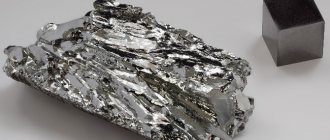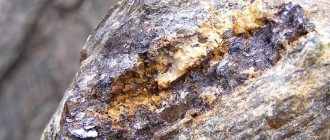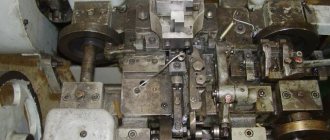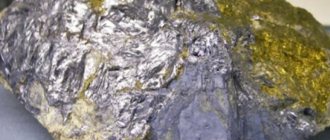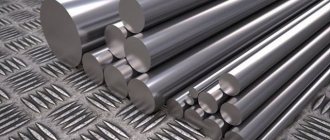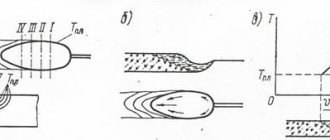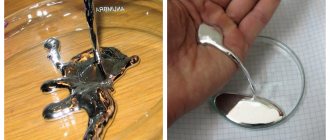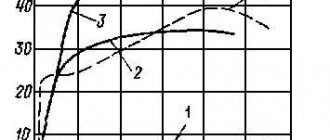MOLYBDENUM – (Molybdenum), Mo – chemical element 6 (VIb) of group of the periodic system, atomic number 42, atomic mass 95.94. There are 31 known isotopes of molybdenum from 83Mo to 113Mo. Of these, the stable ones are: 92Mo, 94Mo – 98Mo. Six of these isotopes and 100Mo (T½ = 1.00 1019 years) are found in nature: 92Mo (14.84%), 94Mo (9.25%), 95Mo (15.92%), 96Mo (16.68%) , 97Mo(9.55%), 98Mo(24.13%), 100Mo(9.63%). The most unstable isotopes of element No. 42 have half-lives less than 150 ns. The most stable oxidation state is +6.
Being in nature
The occurrence of free molybdenum in nature has not been recorded. But two dozen minerals based on it have been identified. The most notable: molybdenite, molybdite, wulfenite.
Molybdenite from Australia
In the earth's crust the element is distributed evenly. Also found in rivers, seas, fossils of organic origin (plant ash, coal, oil). However, the total mass content of the metal is hundredths of a percent.
World reserves of molybdenum are estimated at 11.5 million tons.
Australia and both Americas (USA, Canada, Mexico, Chile) have large deposits. In Europe – Russia and Norway.
Mining is carried out using closed or open-pit methods.
Metal discovered in space. Its concentrations are off the charts in systems with a central star - a red (super) giant and a neutron star inside it.
Production
Molybdenum deposits and its production by country
| A country | Deposits (thousand tons) | 2001 | 2002 | 2003 | 2004 | 2005 | 2006 | 2007 | 2014 |
| USA | 2700 | 37,6 | 32,3 | 29,9 | 41,5 | 58,0 | 59,8 | 59,4 | 68,2 |
| China | 3000 | 28,2 | 30,33 | 32,22 | 29,0 | 40,0 | 43,94 | 46,0 | 103,0 |
| Chile | 1905 | 33,5 | 29,5 | 33,4 | 41,48 | 47,75 | 43,28 | 41,1 | 48,8 |
| Peru | 850 | 8,35 | 8,32 | 9,63 | 9,6 | 17,32 | 17,21 | 17,25 | 17,0 |
| Canada | 95 | 8,56 | 7,95 | 8,89 | 5,7 | 7,91 | 7,27 | 8,0 | 9,7 |
| Russia | 360 | 3,93 | 4,29 | 3,57 | 3,11 | 3,84 | 3,94 | 4,16 | 4,8 |
| Mexico | 135 | 5,52 | 3,43 | 3,52 | 3,7 | 4,25 | 2,52 | 4,0 | 14,4 |
| Armenia | 635 | 3,4 | 3,6 | 3,5 | 3,0 | 2,75 | 3,0 | 3,0 | 7,1 |
| Iran | 120 | 2,6 | 2,4 | 2,4 | 1,5 | 2,0 | 2,0 | 2,5 | 4,0 |
| Mongolia | 294 | 1,42 | 1,59 | 1,6 | 1,7 | 1,19 | 1,2 | 1,5 | 2,0 |
| Uzbekistan | 203 | 0,58 | 0,5 | 0,5 | 0,5 | 0,57 | 0,6 | 0,5 | 0,5 |
| Bulgaria | 10 | 0,4 | 0,4 | 0,2 | 0,2 | 0,2 | 0,4 | 0,4 | ? |
| Kazakhstan | 130 | 0,09 | 0,05 | 0,05 | 0,23 | 0,23 | 0,25 | 0,4 | — |
| Kyrgyzstan | 100 | 0,25 | 0,25 | 0,25 | 0,25 | 0,25 | 0,25 | 0,25 | ? |
| Others | 1002 | — | — | — | — | — | — | — | — |
| Total | 11539 | 134,4 | 124,91 | 129,63 | 141,47 | 186,26 | 185,66 | 188,71 |
Genetic groups and industrial types of deposits
1. Contact-metasomatic (skarns).
2. Hydrothermal.
A. High temperature (greisen). B. Medium temperature. A. quartz-molybdenite. b. quartz-sphalerite-galena-molybdenite. V. quartz-chalcopyrite-molybdenite (porphyry copper ores). pitchblende-molybdenite.
How it was opened
The history of the discovery of the element begins in the second half of the 18th century.
Shiny silver-white metal
It was written by three scientists:
- Swedish chemist Karl Scheele obtained the oxide.
- The Frenchman Pierre Guelm isolated the metal. But its purity was symbolic.
- The production of metal almost without “dirt” is the merit of the patriarch of European chemists, Swede Jens Berzelius. This happened at the dawn of the 19th century.
A century later, the era of the heyday of metal began.
Molybdenum steel was smelted in tons for the needs of the armies that fought on the fronts of the First World War.
Later they developed a technology for producing metal using powder metallurgy.
The name of the element is of ancient Greek origin: μόλυβδος means “lead”.
It was molybdenite that caused the confusion. It was obtained first, but the shine of the substance copied lead.
For the same reason, until the 18th century, molybdenum was called graphite.
Advantages/disadvantages
- Advantages:
- has a high melting point, and therefore heat resistance;
- because the density of this metal (10200 kg/m3) is almost two times less than the density of tungsten (19300 kg/m3), then molybdenum-based alloys have significantly greater specific strength (at temperatures below 1370 °C);
- has a high elastic modulus;
- low temperature coefficient of expansion;
- has good heat resistance;
- small cross section for thermal neutron capture;
- Molybdenum is characterized by high corrosion resistance. This metal is stable in most alkaline solutions, as well as in sulfuric, hydrochloric and hydrofluoric acids at different temperatures and concentrations.
- Flaws:
- has little scale;
- high fragility of welds;
- low plasticity at low temperatures;
- work hardening can be used only up to 700-800 °C; at higher temperatures, softening occurs due to return.
Physico-chemical characteristics
Molybdenum has many advantages:
- Elasticity, almost zero expansion when heated, resistance to heat and corrosion.
- Electrical conductivity is higher than iron.
- Only tungsten has higher mechanical strength. But under pressure, molybdenum is processed more easily.
- The main chemical property of the metal is its resistance to almost all alkaline solutions and aggressive acids, regardless of their concentration and temperature.
Disadvantages of metal: fragility when welding, insignificant ductility.
| Properties of the atom | |
| Name, symbol, number | Molybdenum / Molybdaenum (Mo), 42 |
| Atomic mass (molar mass) | 95.96(2) a. e.m. (g/mol) |
| Electronic configuration | [Kr] 4d5 5s1 |
| Atomic radius | 139 pm |
| Chemical properties | |
| Covalent radius | 130 pm |
| Ion radius | (+6e) 62 (+4e) 70 pm |
| Electronegativity | 2.16 (Pauling scale) |
| Electrode potential | −0,2 |
| Oxidation states | 6, 5, 4, 3, 2 |
| Ionization energy (first electron) | 684.8 (7.10) kJ/mol (eV) |
| Thermodynamic properties of a simple substance | |
| Density (at normal conditions) | 10.22 g/cm³ |
| Melting temperature | 2623 °C |
| Boiling temperature | 4885K |
| Ud. heat of fusion | 28 kJ/mol |
| Ud. heat of vaporization | ~590 kJ/mol |
| Molar heat capacity | 23.93 J/(K mol) |
| Molar volume | 9.4 cm³/mol |
| Crystal lattice of a simple substance | |
| Lattice structure | cubic body-centered |
| Lattice parameters | 3.147 Å |
| Debye temperature | 450 K |
The negative characteristics of molybdenum appear only at ultra-low temperatures or incorrect use.
Physical properties
The use of molybdenum depends on its properties and characteristics. The inherent physical properties of molybdenum are given below:
- metal type - high temperature melting;
- molybdenum color – lead;
- molybdenum density - 10.2 g/cm3;
- melting at a temperature of 2615°C;
- boiling at a temperature of - 4700°C;
- thermal conductivity - 143 W/(m K);
- thermal capacity - 0.27 kJ/(kgK);
- energy for melting - 28000 J/mol;
- energy for evaporation - 590000 J/mol;
- linear expansion, coefficient - 6·10-6;
- electrical resistance - 5.70 μOhm cm;
- calculated volume - 9.4 cm3/mol;
- shear force - 122·10·6 Pa;
- hardness - 125 HB;
- magnetic permeability -90·10-6.
This metal is not often subjected to turning, but processing is carried out with a standardized tool.
Grades and alloys
Industry uses molybdenum as a pure metal, with additives and alloys.
The range of brands includes dozens of items. There are several most common ones:
| Brand | Characteristics |
| MCH | Mo – no additives. |
| MChVP | Mo – no additives, melted in vacuum. |
| MRN | Mo – there are no additives, but there are impurities. |
| MK | Mo + additive (alkali silicon). |
| CM | Mo + additive (zirconium or titanium). |
| MV | Molybdenum-tungsten alloy. |
| MR | Molybdenum-rhenium alloy. |
Additions of Mo (less than a percent) to structural steels multiply their toughness, strength, and corrosion resistance.
To increase the hardness of the metal, cobalt-chromium alloys are used.
Alloys “molybdenum + nickel + cobalt + chromium” increase resistance to acids and heat.
Obtaining molybdenum
The raw materials from which metallic molybdenum is produced are molybdenum concentrates. They contain about 50% of this element. They also contain: sulfur ~ 30%, silicon oxide (up to 9%) and about 20% of other impurities.
The concentrate is pre-fired for additional oxidation. The process is carried out in two types of furnaces: multi-hearth or fluidized bed. Firing temperature 570 °C - 600 °C. The result is cinder - MoO3 and impurities.
In the next step, impurities are removed to obtain pure molybdenum oxide. Two methods are used:
- Sublimation at a temperature of 950 °C - 1100 °C.
- Chemical leaching. The essence of the method is that when interacting with ammonia water, impurities of copper and iron are eliminated and molybdenum carbide is obtained, which is crystallized by evaporation or neutralization. Next, the carbide is heated and maintained at temperatures up to 500°C. The output is pure MoO3 oxide, in which the impurity content is only 0.05%.
Molybdenum production is based on the reduction of MoO3. The process is carried out in two stages:
- In a tube furnace at a temperature of 550°C - 700°C, oxygen atoms are separated in a flow of dry hydrogen.
- Then the temperature rises to 900°C - 1000°C and final recovery occurs. The resulting metal is in powder form.
To obtain a monolithic metal, powder is melted or sintered. Melting is used when producing workpieces weighing more than 500 kg. The process is carried out in arc furnaces with a cooled crucible, into which a consumable electrode is supplied from previously sintered rods.
Obtaining molybdenum
Powder sintering is pressing in a hydrogen atmosphere at high pressure (2000-3000 atmospheres) and temperature (1000°C - 1200°C). The resulting bars are subjected to sintering at high temperatures equal to 2200°C - 2400°C. Subsequently, molybdenum is given the required shape through pressure treatment - forging, rolling, broaching.
Ferromolybdenum, which contains up to 60-70% molybdenum and the rest is iron, is widely used in industry. It is obtained by introducing molybdenum additives into steel. The alloy is produced by reducing cinder with iron silicate with the addition of steel filings and ferrous ore.
Where is it used?
The refractoriness, variety and ease of processing of the metal, and other physical and chemical properties have determined the areas of use of products made from it.
Metallurgy
The main consumer of raw materials is metallurgy. Its products from molybdenum are wire, rods, powder, sheet, and rod.
Molybdenum powder
These are blanks for a range of products produced by almost all industries.
Other industries
The lion's share of products made from molybdenum and metal alloys is taken by manufacturers of radio and electric lamps, radio electronics.
There is enough material for other purposes:
- Molds, machine parts for injection molding of alloys.
- Electrovacuum production (X-ray tubes).
- Positive electrode of lithium-based current sources.
- Shells of nuclear reactor parts.
- Heaters for electric furnaces operating in harsh conditions.
- The outer layer of the “nose” segment of the body of supersonic aircraft.
- Electrodes for glass melting.
- Catalysis of chemical reactions.
- Varnishes, paints for porcelain, textiles, furs.
These products are created on the basis of natural compounds and metal alloys.
The newest area of application of molybdenum is space technology.
Assortment: components of rocket (ion, plasma) engines; skin of descent vehicles; heat exchangers. Here, the properties of molybdenum are corrected by alloys with niobium and tantalum.
Pure crystalline Mo is used as a component of mirrors for special purpose lasers.
Microdoses of metal are added to agricultural fertilizers.
Molybdenum Processing
Processing of molybdenum is difficult due to its low viscosity at low temperatures. It also has low ductility, so the following methods are used for its processing:
- hot deformation:
- forging;
- rolling;
- broach;
- heat treatment;
- mechanical restoration.
When processing small workpieces, crimping machines are used. Large billets are rolled on small mills or shaped on broaching machines.
Appearance of molybdenum
If there is a need for machining by cutting, then machining of molybdenum is carried out with a tool made from high-speed steel grades. The sharpening of tool corners during turning should correspond to the sharpening angles for machining cast iron.
The heat treatment of molybdenum is characterized by high hardenability due to its content in steels. The hardening carried out increases the hardness and wear resistance of critical parts.
Meaning for humans
The effect of molybdenum on living organisms was studied by the middle of the 20th century.
It turned out that this microelement:
- Regulates the synthesis of amino acids.
- Activates antioxidants, including ascorbic acid.
- It is part of enzymes and the tissue respiration system.
Mo deficiency in the body is signaled by weakened immunity (fatigue, frequent illness).
Molybdenum dust is toxic. Its prolonged inhalation provokes blood diseases and irreversible destruction of the lungs.
Application
OK. 75% of the metal produced is used for alloying steels; the rest is used as a component of heat-resistant and anti-corrosion alloys (see Molybdenum alloys), for the manufacture of parts for electric vacuum devices and evaporation units, heating elements of high-temperature furnaces, as structural components. material for molybdenation of metal surfaces. products. M compounds are used in the production of varnishes and paints, microfertilizers, and as catalysts in chemicals. and petrochemical industry, etc.; MoS2 – as an effective lubricant (area of use from –40 to 350 °C).
Synthetic analogues
It is not produced in the form of pharmaceuticals. But it is present in numerous dietary supplements and multivitamin complexes (MultiMax, Alphabet, Duovit, Centrum, Vitrum, etc.).
These drugs are used as general strengthening, immunostimulating agents, as a prophylaxis and auxiliary treatment of diseases of the gastrointestinal tract, heart, blood vessels, kidneys, nervous and reproductive systems.
Another drug, Molybdenum 99, is used in medicine, but not for medicinal, but for diagnostic purposes. To diagnose a heart attack, tumor processes, and a number of other diseases, radioisotope scanning is used.
Healthy and diseased organs absorb radioisotopes differently, and these changes are clearly visible in a special device, a gamma camera.
Technetium 99 is used as a radioisotope. And the raw material for its production is another radioisotope, Molybdenum 99, 99Mo. It differs from stable molybdenum, 98Mo, 99Mo by the “extra” neutron in the atomic nucleus. 99Mo is produced during nuclear reactions from uranium or its stable variant.
Daily requirement
It is not precisely defined, and the figures given are largely advisory in nature.
| Category | Daily value, mcg |
| Infants under 2 years old | 5-6 |
| Children 3-5 years old | 8-10 |
| Children 6-8 years old | 10-20 |
| Children 9-13 years old | 20-30 |
| Teenage boys | 50-60 |
| Teenage girls | 40-50 |
| Adult men | 70-80 |
| Adult women | 70 |
| Pregnant | 80 |
In case of severe illness or physical activity, the need for Mo may increase to 100 mcg. Some believe that in extreme situations, in pathological conditions, molybdenum is needed even more - up to 300-400 mcg/day.
Production of alloy steels
Ferrous metallurgy uses molybdenum powder. Where is it used? For alloying steels and cast irons. The addition of this element to the composition of alloys significantly improves their quality. Increases elasticity, wear resistance, and impact resistance. About 0.5% molybdenum is added to structural steels, this makes their structure fine-grained and more uniform, reducing the fragility of the final products.
The addition of other substances makes it possible to obtain special compositions that are widely used in various industries. Alloys that include cobalt and nickel (50-60%), as well as chromium (about 20-28%), are alloyed by adding molybdenum. Where is this material used? The answer lies in its special properties - high heat resistance. It is used in the manufacture of skin parts for aircraft and missiles.
Precautionary measures
Regarding possible drug interactions, high doses have been found to inhibit the metabolism of acetaminophen in rats, so taking acetaminophen with this element is not recommended (4).
People who are deficient in dietary copper or have disorders of copper metabolism that lead to their copper deficiency may be at increased risk of developing molybdenum toxicity.
You should not take this trace mineral supplement if you have gallstones or kidney problems.
If you are pregnant or breastfeeding, have a medical condition, or are currently taking medications, always talk to your doctor before taking any new supplement.
Final Thoughts
- Molybdenum is necessary for the body to include the breakdown of macronutrients, enzyme-dependent processes, iron metabolism and detoxification from harmful substances.
- The benefits of molybdenum may include preventing or improving some health problems, but to date there has been limited research to definitively support the need for supplementation, especially when deficiency is so rare.
- One example of a condition that it may help is esophageal cancer, as studies have shown that its deficiency may play a role in the higher incidence of esophageal cancer in populations consuming food grown in soil low in this mineral.
- Healthy foods that contain this element include lentils, dried peas, black beans, oats and romaine lettuce.
- The best and safest way to obtain this micronutrient is through diet, especially since deficiency is extremely rare.
- Excessive amounts of this trace mineral through supplements (or industrial exposure) can cause gout and/or copper deficiency.
